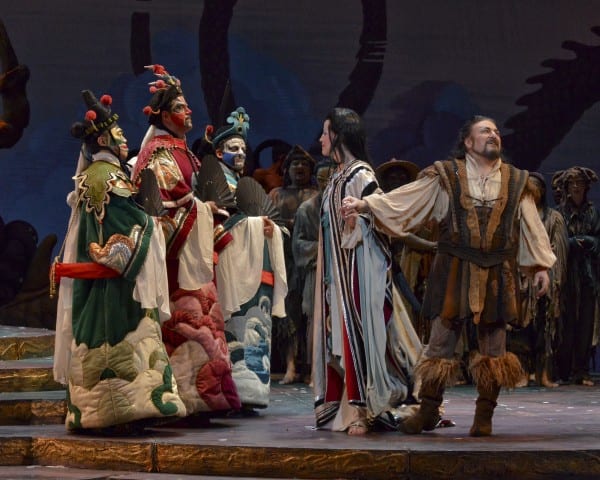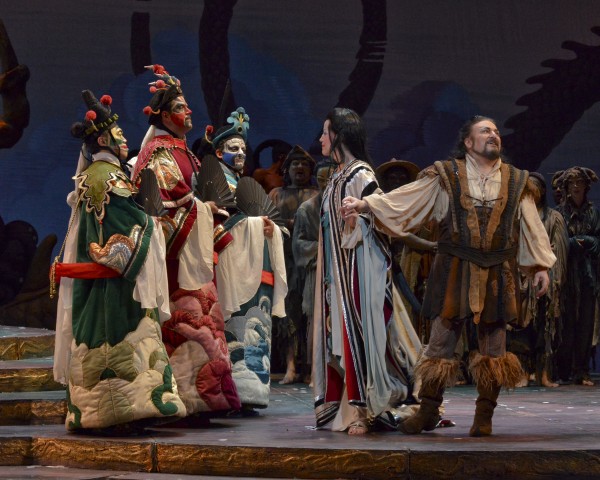How unfair the opera world is: Turandot gets her name in the title, Calaf gets the big, famous aria, but Liu? She gets the tragic love story, the brutal ending and, at least in the Dallas Opera’s current production of Puccini’s last opera, the pipes. She’s the emotional focus, the true tragic hero, of this Turandot. Hei-Kyung Hong transforms the opera, wonderfully achieving emotional beauty in a powerful interpretation; she rips the rug right from under the others. That’s an accomplishment, since all the principals do excellent work.
Antonello Palombi as Calaf does well in Acts 1 and 2, but the disappointment is his “Nessun Dorma,” which for unfathomable reasons he sings mostly while sitting down, robbing his diaphragm of is strength. Aside from a technical glitch (a big one) in Act 1 of opening night, the production is a marvel of beauty and moody lighting, under Garnett Bruce’s direction an expert management of the chorus by Alexander Rom. This is your last weekend to see it, so get moving.
 From the operatic stage to the balletic medium of film is quite a leap, but balletic is the only term to apply to Terrence Malick’s To the Wonder. By my count, only four filmmakers of the past 40 years — the late Stanley Kubrick, Jean-Jacques Annaud, David Lynch and Malick — truly qualify as cinematic artists: Directors more concerned with making visionary works that serving a commercial or even accessible audience. (A fifth, Ang Lee, is well on his way to that status as well.) These are men who make movies on their terms, inventing their own idioms and grammar. They refer almost to nothing and no one. That’s what artists get to do.
From the operatic stage to the balletic medium of film is quite a leap, but balletic is the only term to apply to Terrence Malick’s To the Wonder. By my count, only four filmmakers of the past 40 years — the late Stanley Kubrick, Jean-Jacques Annaud, David Lynch and Malick — truly qualify as cinematic artists: Directors more concerned with making visionary works that serving a commercial or even accessible audience. (A fifth, Ang Lee, is well on his way to that status as well.) These are men who make movies on their terms, inventing their own idioms and grammar. They refer almost to nothing and no one. That’s what artists get to do.
Of course, that’s not to say they make only good films; Malick, in his 40 years, has produced only six films: One’s a bore (The New World), two are interesting mood pieces (Days of Heaven and The Thin Red Line) and two are masterworks (Badlands and 2011’s The Tree of Life). I haven’t decided exactly where his newest, To the Wonder, falls: Tree of Life was an evolutionary leap forward from his previous work, a stunning reverie on the nature of our existence. Wonder is something of a sequel, though one with less grand aspirations. Malick explores the nature of human relationship without direct reference to our place in the universe, though he does seem concerned with our relationship to God as well.
To accomplish this, he tells his story almost exclusively in voice-over as an American visiting Paris (Ben Affleck) convinces his French girlfriend (Olga Kurylenko) and her daughter to return with him to the U.S. Once here, they drift apart, and he rekindles a past love (Rachel McAdams) while a priest (Javier Bardem) struggles with his own lack of faith.
The stories never converge in the way that, say, Crash did so heavyhandedly (and Cloud Atlas did so beautifully), but rather run parallel, giving us fodder to consider what we really want and who can give it to us.
The narration, poetic and obtuse, provides some context, but the true beauty and meaning of the film is conveyed visually in Malick’s inimitable way. Even when he’s shooting motel parking lots and polluted rivers, there’s a grace present in Malick’s camerawork; on more than one instance (one, near the end, simply a shot of two rooms in a house with different people occupying each — lost, alone) is quite literally breathtaking — you’ll gasp. The camera seems to drift on air, in and out as people touch but often don’t connect. The familiarity of it all will likely trigger unique emotionally responses in each viewer.
Of course, this silent beauty can sometimes come across as precious and self-indulgent; more than once, I felt I was watching a TV ad for Summer’s Eve. But To the Wonder is experimental filmmaking at its most humanistic. Like it or not (and, ultimately, I did, though not as much as Tree of Life), it reinvents cinema. (Now playing at the Angelika Film Center Mockingbird Station.)


